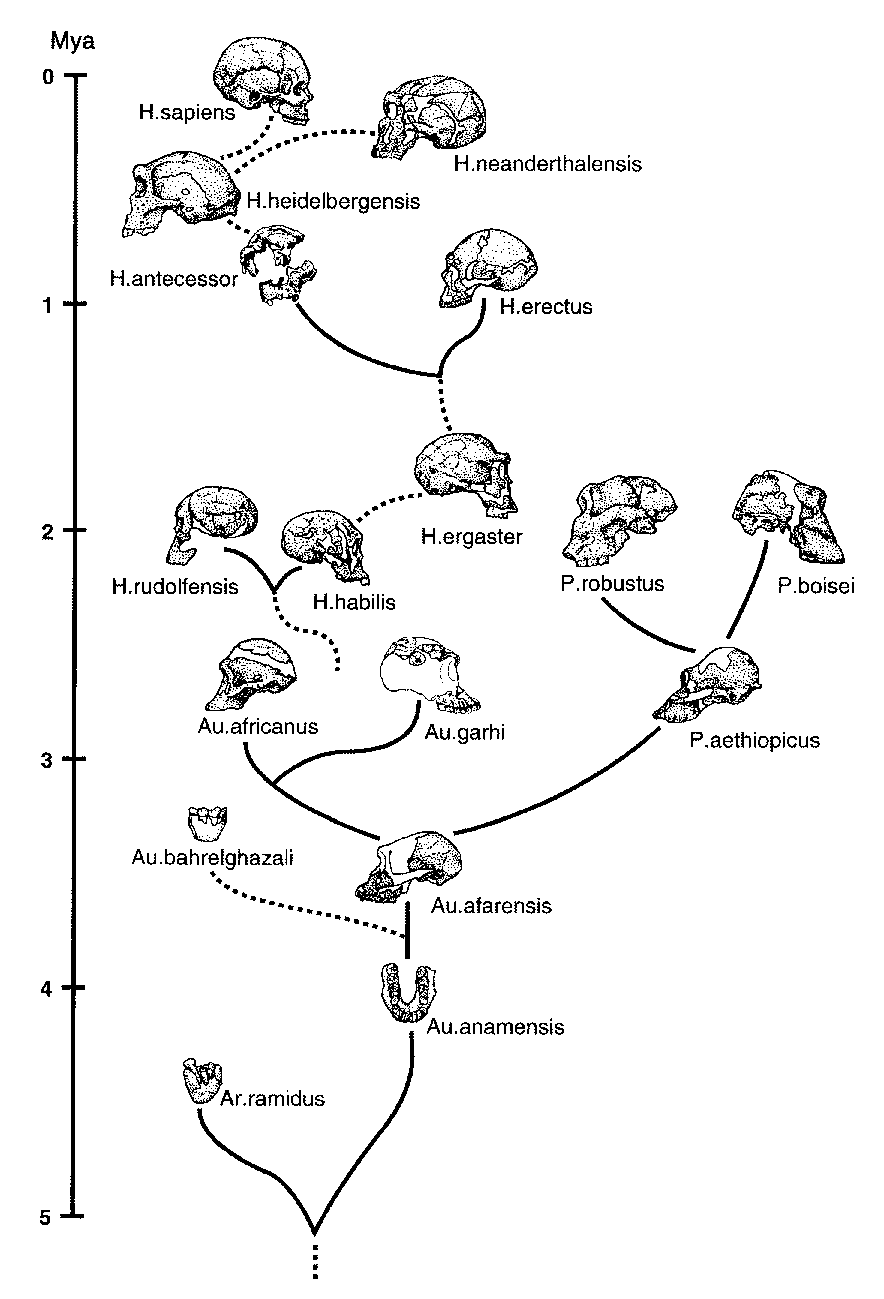Most archeologists agree that both Neanderthals and AMH emerged out of Homo erectus. The first H. erectus wave out of Africa is evidenced by specimen remains in Dmanisi, Ubeidiya, Zhoujoudian, and Trinil. Such a wide geographical range!
 |
| Bits of Homo antecessor |
These specimens had distinct morphological characteristics (Maher 2012). For example, the Trinil H. erectus had more robust features than the Zhoukoudian H. erectus: its jaws were massive, its teeth are much larger, and its saggital keel and brow ridge were much more pronounced. Despite undeniable differences between H. erectus specimen, many archeologists consider the specimen in Gran Dolina, Atapuerca, Spain, to be its very own species--Homo antecessor.
Homo heidelbergensis is often considered to be the last common ancestor of Neanderthals and AMH. This species first emerged out of Africa, but soon migrated to Europe and possibly to southern Asia by about 500, 000 kya.
 |
Homo heidelbergensis |
http://en.wikipedia.org/wiki/Atapuerca_Mountains
Homo heidelbergensis had a larger brain case, overlapping with the AMH average. They were also comparably tall at 6.0 ft, but more muscular. They used Acheulian tools, much like Homo erectus before them. Later populations were known to have also made tools from deer antler, bone and wood in addition to flint. There's plenty of evidence that they used weapons to hunt, like cut marks on large wild game.
http://www.echo-news.co.uk/news/local_news/southend/8232259.Humans_roamed_south_Essex_600_000_years_ago/
http://www.echo-news.co.uk/news/local_news/southend/8232259.Humans_roamed_south_Essex_600_000_years_ago/
Neanderthals probably diverged from Homo heidelbergensis. The first Neanderthal specimen is dated to roughly 150,000-200,000 BP. However, some archeologists would date their emergence as late as 120,000 BP, and attribute earlier specimens to the Homo heidelbergensis. It's quite difficult to distinguish between the two species: their morphological characteristics were very similar.
The name "Neanderthal" derives from the Neander Valley near Dusseldorf, Germany. The specimens discovered at the site in 1856 were later found to be abnormal modern humans rather than archaic hominids. Two true Neanderthal skeletons were discovered in a cave at Spy, Belgium in 1886.
The name "Neanderthal" derives from the Neander Valley near Dusseldorf, Germany. The specimens discovered at the site in 1856 were later found to be abnormal modern humans rather than archaic hominids. Two true Neanderthal skeletons were discovered in a cave at Spy, Belgium in 1886.
Bibliography
- Brown, Graham , Stephanie Fairfax, Nidhi Sarao , and S. Anonymous . "Human Evolution." Tree of Life Web Project. Origins Institute at McMaster University , n.d. Web. 4 Nov. 2012. <http://tolweb.org/treehouses/?treehouse_id=3710>.
- Dorey , Fran . "Homo antecessor - Australian Museum." Australian Museum - nature, culture, discover - Australian Museum. N.p., 2 Oct. 2009. Web. 31 Oct. 2012. <http://australianmuseum.net.au/Homo-antecessor/>.
- "Homo heidelbergensis - Wikipedia, the free encyclopedia." Wikipedia, the free encyclopedia. N.p., 2 Oct. 2012. Web. 31 Oct. 2012. <http://en.wikipedia.org/wiki/Homo_heidelbergensis>.
- Klein, Richard . "Neanderthal Range Map." Daily Nature and Science News and Headlines | National Geographic News. N.p., 6 May 2003. Web. 4 Nov. 2012. <http://news.nationalgeographic.com/news/2003/03/photogalleries/neanderthal/>.
- Maher, Lisa. "From H. erectus to Neanderthals--Out of Africa I". Anthro 128, UC Berkeley, 105 Stanley, 9/7/2012
- "Neanderthal - Wikipedia, the free encyclopedia." Wikipedia, the free encyclopedia. N.p., 8 Oct. 2012. Web. 4 Nov. 2012. <http://en.wikipedia.org/wiki/Neanderthal>.
- Pedersen, Kristian. "Neanderthals, Lecture 9." Upload & Share PowerPoint presentations and documents. N.p., 15 Mar. 2010. Web. 31 Oct. 2012. <http://www.slideshare.net/KLRPedersen/neanderthals-lecture-9>.
- Semal , Patrick et al . "New Data on the Late Neandertals: Direct Dating of the Belgian Spy Fossils." American Journal of Physical Anthropology 138 (2009): 421-428.


No comments:
Post a Comment